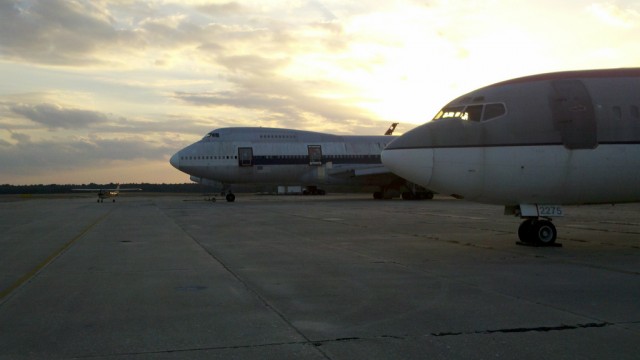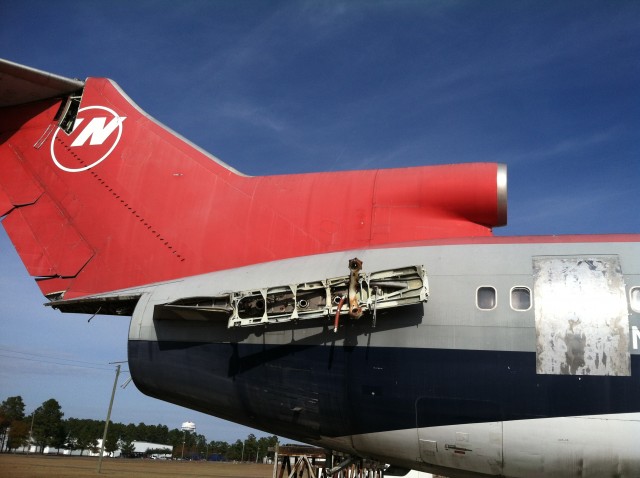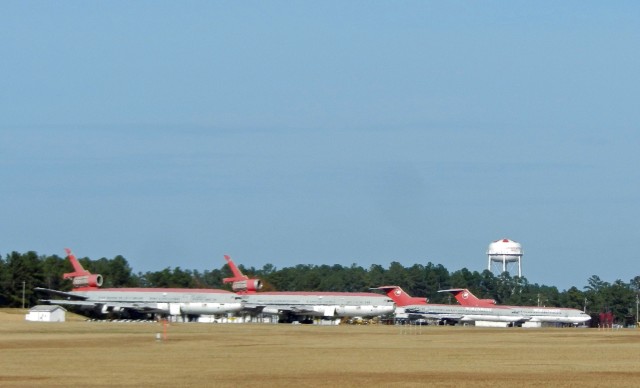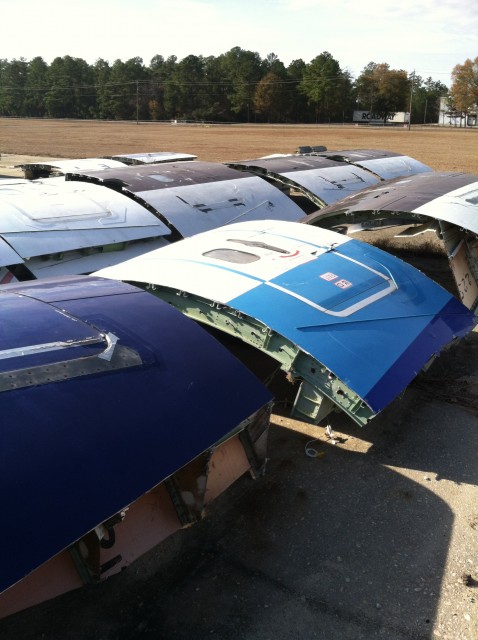
Noses of a Boeing 747 and 727 – Photo: Caleb Howell | Flickr CC
This guest post was written by Andrew Vane (@pipelinedrew) for AirlineReporter.
Recently I saw that someone posted pictures of old Northwest 727s and DC-10s in North Carolina and I became curious. This is my home turf and I was not aware of any tri-holers “enjoying” their retirement years nearby.
I quickly started looking up Google Earth images and was able to confirm that, sure enough, there was what was left of some vintage aircraft stored in an out-of-the-way airfield somewhere in my home state. Now, how to get out there to see them.
Laurinburg-Maxton Airport (KMEB) is nestled in the pine barrens of the south-central part of North Carolina, off of US Highway 74 about halfway between Charlotte and Wilmington. Originally a U.S. Army Air base for glider training during World War II, this small airport currently is the home to the U.S. Army Golden Knights parachute team, has a nice local Fixed Base Operator (FBO) for civil air service, and also holds something not often seen in the eastern U.S.; a commercial airliner salvage yard.
When you normally think of aircraft storage, the first airports that come to mind are Victorville, California and Tucson, Arizona. Now add KMEB to that list.
Originally formed in 1953, Charlotte Aircraft Corporation currently uses portions of the airfield for aircraft storage and salvage. Most major industries make their money not on the products they primarily manufacture, but on spare parts orders.
As the story goes, the founder Harold Jenkins ’œJenks’ Caldwell Sr. was in a restaurant and noticed that a portion of the building was constructed of the fuselage of an old Army C-54 transport aircraft. He purchased the airframe, pulled it out of the concrete, obtained more parts, and built himself a fully fly-able aircraft for commercial service.
His intention was not to sell it, but to also start his own small airline – which he did. Over the years, the small airline grew to include DC-8s and 707s. Eventually, the company transformed into a salvage operation, selling parts of the various aircraft to commercial and private companies.
Today, the company has on-site two 747-100s, a 757, five 727s, two DC-10s (all former Northwest Airlines birds), and an A300. While most of the big airlines don’t fly DC-10s or 727s anymore, there are plenty still flying. FedEx is due to fully retire their DC-10 fleet in the near future.
Boeing 727s are still flown in the US by some smaller charter and cargo airlines like Cargojet and Kalitta Air, and private carriers like Roush Air (which flies the Roush Racing NASCAR teams to racing venues across the US). A number of 727s are still active by some small foreign airlines and governments in Africa and Latin America.
In the wide-body market, FedEx currently operates over 60 DC-10s. Also, the KC-10 tanker used by the U.S. military for refueling is expected to see service for quite some years to come. Although not the size of the modern Airbus or Boeing spare parts market for active aircraft, Charlotte Aircraft has filled a nice niche in the retro aircraft small parts market.
When a new aircraft arrives, the coveted name plate you often see above the door to most Boeing aircraft is the first to get removed and sent back to the manufacturer. Then, the engines are sold, which can fetch over $2 million. The rest of the parts are removed and sold as the market warrants.
I was ecstatic to walk into a warehouse full of flight engineer panels, air frame supports, and DC-9 tail cones. They also had a nice set of emergency window pieces.
After checking in with the FBO and local Charlotte Aircraft people, I enjoyed a brief walk around two of the 727s. The Boeing 727 was the best selling commercial aircraft of all time for the first 30 years of jet service, and held this record until the 737 eventually surpassed it. However, these birds flew commercially as recently as 2000, carrying over four billion passengers in their history.
Even though the engines had been removed, it was great to walk around them, touch the leading edges of the wings, and admire the red and gray colors of an airline which morphed into Delta a few years back. I was tempted to see if the air stairs could be opened but decided against disturbing the vast number of birds inhabiting all the open nooks and crannies.
After viewing the 727s, I wandered over to the mighty DC-10s. Amazing that these tri-jets outlived their Lockheed competition (L1011) in passenger service by two decades and just recently retired. You don’t fully appreciate how large these aircraft are until you walk under one without coming close to hitting your head.
It’s apparent that the engines and rudders are the most popular parts sold. The open cargo door afforded me a glimpse into just how much space there is beneath the passengers in these old birds. Its no wonder they’re still used for bulk fuel and cargo transport today. The other aircraft were unfortunately too far away for me to get an up close and personal view, but perhaps another day.
The airport also has plenty of room to spare for future aircraft and the location affords most carriers a shorter trip at the end of their service life than having to fly all the way out west to Victorville, CA.
If you do choose to visit Laurinburg-Maxton airport, keep in mind that, like all airports, security is of the utmost importance. Be sure to stop by the FBO and let them know you’re there to take pictures before hanging out near the fence. Better to be upfront and safe than draw unnecessary attention and a possible visit from local law enforcement.
While I’m on the subject of the FBO, I always appreciate the character and love of flying that emanates from the photos, models, posters, and people within the walls of the FBO’s at small civilian airports. They resemble what my bedroom looked like when I was growing up and how I’m trying to make my office look today. They are worth a visit all on their own in most cases anyhow.



Another east coast boneyard is Orlando Sanford International Airport, where many DC-10’s, A300’s, former NWA DC-9’s and Air France’s first A320 were scrapped as well as some early A340’s that had some economically unfeasible repairs due.
The good old days were DC3 ,4,6,7 and Connie’s CV240,340,440 and so on. The early Jets were ok but ……………….
That’s an intersting article. By any chance there wasn’t a 737-200 hulk, ex Olympic reg N322XV, a long term resident of the Maxton Laurinburg airport (since 1991), still there? She seemed to be parked up away from the regular scrapline. This aircaft was the second 737 delivered to New Zealand in 1968 as ZK-NAD (msn 19930/ln66) and the only early one still in existence from our one time fleet, and I’ve been on a push to get the plane dismantled and shipped back to NZ, to mark over 45 years of 737s being the constant backbone of our domestic (due to close as our current -300s are being phased out for A320s). The series 200 especially did 33 years of passenger service in our nation, and 44 when a combi that shifted the post is counted. one of the most significant aircraft of our nation’s aviation heritage.
Just recently a large museum here has announced their intention to ass a 737-200 to their collection, and this would be ideal, and hopefully obtain time expired engines and others. Attempts to contact the airport or whoever owns her not got any response.
I was transferred from Denver to Tucson in the 80 s, as I headed south on I-10 I passed Marana Air Park and I could see dozens of 747’s, DC-10’s, 727s and Classic 737-100, 200s. It was a bit of a shock that Tucson’s airport was such a large facility having so many jumbos flying in and out. The first time I mentioned my impressions of the airport to my neighbors they doubled up in laughter saying: “Everybody makes that mistake the first time they visit Tucson”. So I guess I wasn’t so droopy after all.
Hey SJ,
I think when you live around it, you do not notice as much. But it is quite the sight to see right?
David | AirlineReporter
I just found this article and absolutely love it. I am one of Jenks Caldwell’s granddaughters and grew up around these planes, both in Laurinburg and at the Charlotte Aircraft air base in Charlotte. We loved playing on these planes during our childhood – they were great for hide and seek with all of my cousins (especially the 2 store planes)! We still have old Delta silverware and porcelain dishes from back when the airlines used the good stuff for food service on flights. Wonderful memories.
Hey! I”m a photographer from Greenville sc. do you know who I can contact to get into old airport to photograph planes?
Thank you
Ali
Mr. Jeffery although it was four years ago, as of a visit three weeks ago that aircraft is still present at this airport. I’m not sure of it’s original placement, but it is located in a very far, back corner. Most of the paint has been stripped away by the elements. Interestingly enough it has the doors that could be found on a Southwest aircraft. I do have a few photographs, a good way to contact me is through my Instagram account @pilot_chris I hope that this helps.
Thanks Christopher. Since my original message, a campaign has formed with the backing of a large transport museum to repatriate this machine, and other historic airframes. https://www.facebook.com/bringourbirdshome/
I’m a resident of Greenville, SC as well. Looking at flying up there soon.
Paul, was just working out there the other day and that 732 is still there. I get the impression that it’s not of much value because of its age and condition, so might be able to get a good deal? Like Christopher mentioned, the doors/frames have been swapped with an ex SWA. It will need a lot love both inside and out to get it presentable though, it’s in pretty rough shape. If you’re interested in it give Jenks Caldwell a call @ 910-844-5775, he is the head of operations/sales for Charlotte Aircraft in Maxton, good guy.
Hi! I was wondering if anyone knew if this area was still open to the public + photographers??
Thank you in advance!
Unfortunately not, they’ve even bulked up security I’ve heard. The company itself isn’t at all receptive to enthusiasts or photographers who inquire, either.